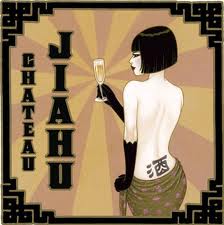 I recently drank the oldest beer in the world. No, it is not some dusty bottle of Uncle Ben’s or Red Cap found buried in my father-in-law’s basement. I am talking about Dogfish Head’s Chateau Jiahu, which is a recreation of a 9,000 year old recipe found in Henan Province, China. To be accurate, the recipe was not discovered. Micro-analysis of clay pots found at an archeological excavation revealed the broad ingredients, and DFH worked out a plausible recipe based upon it.
I recently drank the oldest beer in the world. No, it is not some dusty bottle of Uncle Ben’s or Red Cap found buried in my father-in-law’s basement. I am talking about Dogfish Head’s Chateau Jiahu, which is a recreation of a 9,000 year old recipe found in Henan Province, China. To be accurate, the recipe was not discovered. Micro-analysis of clay pots found at an archeological excavation revealed the broad ingredients, and DFH worked out a plausible recipe based upon it.
The finding was significant as it moved our understanding of the origins of beer back about 4,000 years. For ages we all thought the Sumerians first intentionally brewed beer around 3,000 BCE. It made sense – a grain-based agricultural society, relative prosperity (for the time) and a vibrant religious and cultural life. Sounds like beer time to me. That changed a few years ago when Patrick McGovern found residues of fermented rice, fruit, honey and unidentified spices, pushing back the dates significantly. He offers a full, and very academic, account of the finding in Uncorking the Past, which is a thorough and scientific look at the history of alcoholic beverages.
Some may quibble that the substance was not beer as it contained no barley. Okay. But it had fermented rice, which is a grain, and so it definitely wasn’t wine. It wasn’t distilled so it is not spirits. You could argue that it is the origins of saki, which would be fair, but at its core what is saki other than rice beer (malted grain mashed and fermented… Hmmm)? McGovern deftly sidesteps the debate by calling it “grog”. I am not so timid. I say we claim it as beer.
My Vue Weekly column a few days ago reviewed Chateau Jiahu. I will let you read the review yourself over here, but overall it is a (pricey) bottle I likely will not purchase again. It was simply too cloying and unbalanced. But it was fun closing my eyes and pretending I was a Neolithic Chinese brewer checking my elixir in preparation for the great feast in honour of the coming of spring (or whatever excuses they used for a big party).
By the way, the little known story of the label (found in Uncorking the Past) is that DFH’s Sam Calagione had a dream one night where a naked Asian beauty walked up to him and handed him a glass of the beverage. The tattoo on the woman’s back is the Chinese symbol for alcoholic beverage. Wow, there is some great kegger party trivia for you!
And I can say I feel a little closer to the historical origins of the beverage I spend a lot of time researching, drinking and discussing. Which is kind of cool.

March 22, 2011 at 4:17 PM
Yes I had read about the Chateau Jiahu as well as the Midas Touch & Theobroma on the Dogfish Head site. I’ve seen video reviews of all three online too. They certainly seem like unique brews.
March 24, 2011 at 11:42 PM
I forgot to mention the two Dogfish Head beers I have had. Good enough, but not a big hit with me was their Raison d’Etre(a Belgian-inspired brown ale). Hmm, brewed with beet sugar & raisins…I’ll pass that one up from now on.
http;//tinyurl.com/coz2y9
But I’m quite optimistic about the still unopened Palo Santo Marron, a dark brown(almost stout-like in appearance) ale aged in/on Paraguayan Palo Santo wood. It’s 12% abv, I’m assuming it’ll improve with a bit of age.
http://tinyurl.com/b9kejy
March 24, 2011 at 11:47 PM
http://tinyurl.com/coz2y9 That oughta do it!;-)